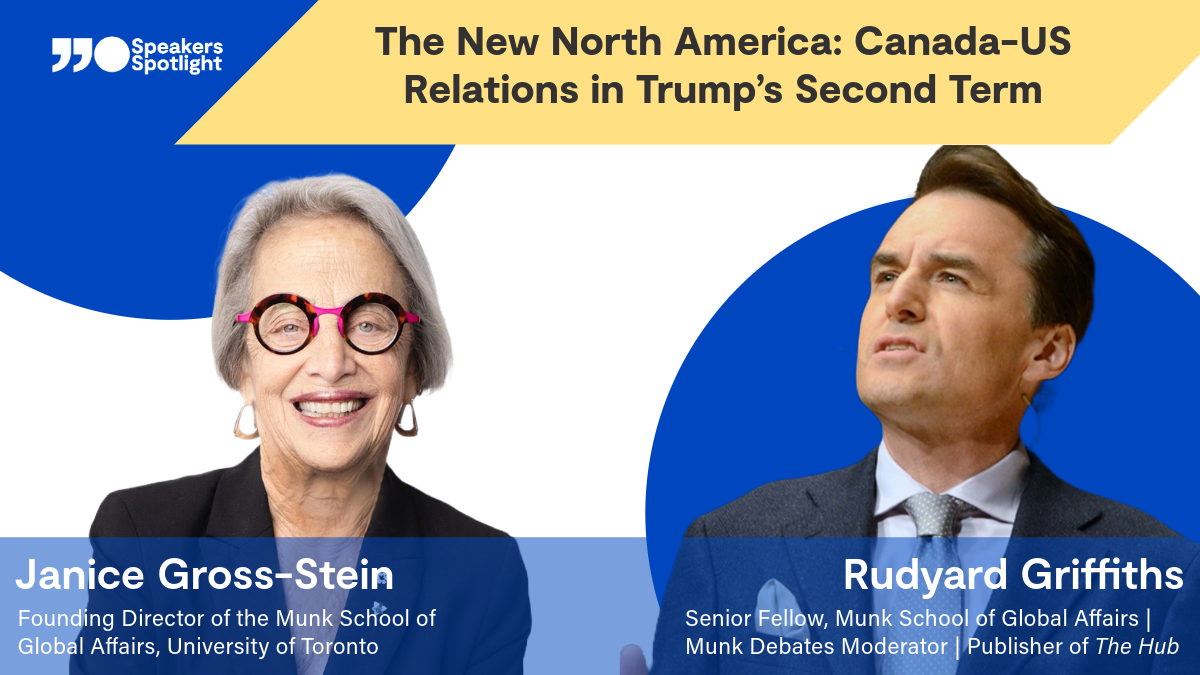The global economic order stands on the precipice of collapse with Canada caught in the crossfire. As tariffs between the United States and China escalate to unprecedented levels — totaling a shocking 104% on Chinese imports to the US at the time of writing — markets are plunging, supply chains are fracturing, and the threat of a global recession is looming. On top of that, Canada is wedged between these two global superpowers, one of which is our largest trade partner, while grappling with our own US-imposed tariffs. Needless to say, Canada’s economic future is shrouded with uncertainty.
To gain some clarity, acclaimed geopolitical experts Professor Janice Gross Stein and Rudyard Griffiths joined us for a special, client-exclusive virtual event. Janice is the Founding Director of the Munk School for Global Affairs and Public Policy at the University of Toronto. Rudyard is a Senior fellow at the same institution as well as the co-founder, chair, and moderator of the acclaimed Munk Debates. Together, they host the weekly podcast, Friday Focus, a 30-minute masterclass on current events.
We were honoured to host a live version of this podcast. In conversation, Janice and Rudyard dug deep into today’s biggest political headlines, sharing invaluable insights into tariffs and the escalating US-China trade war, its implications for Canada’s economy, and how Canadian business leaders can best navigate this volatile new landscape.
The Escalating US-China Trade War: A Perfect Storm
From China’s perspective, this isn’t simply a trade dispute, but “an all-out assault on the Chinese economy”, Janice said. This dangerous “spiral of escalation” between these two superpowers has reached unprecedented levels, pushing the world closer to economic crisis.
How did we get here? While the escalation of tariffs is new, there has been ongoing tension between China and the US for years now. From the US perspective, Janice said, China’s exports have been growing at an exponential pace. If it keeps at this pace, it will swamp the global market. China is the pacing partner of the US.
Xi Jinping, the President of the People’s Republic of China, will see President Trump’s actions as a deliberate attempt to “kneecap” their economy, Janice said. China is particularly vulnerable right now as it’s experiencing high unemployment and a stagnating economy, despite its manufacturing power, she continued. Doubling import costs to the US will be seen as an attempt to contain China and disrupt its growth. It’s essentially a form of warfare.
The Breaking of “Chimerica”
What makes this conflict particularly significant is how it disrupts what Rudyard called the “Chimerica partnership” that has defined our era of globalization. Trump has severed that mutual dependence, representing a profound shift in global economic architecture with far-reaching implications.
The two countries are now at war through trade channels. As someone who has studied global conflict for decades, Janice said it’s hard to break this path of escalation. The question is, how long can either side keep it up? How much market turbulence can they take? Especially when both sides are at risk of “losing face”. Quoting Sergey Radchenko, author of To Run the World, Janice said “Greatness is not simply proclaimed, it has to be recognized.” That’s the issue for China, she continued, they want to be recognized as a peer by the US.
China is responding with sector-specific retaliatory measures. “Americans don’t understand how disruptive this could be,” Janice said, noting that most antibiotics Americans take have a Chinese component in them. The price of essential medications could double.
Canada’s Position: Caught in the Crossfire
For Canada, the situation presents both challenges and potential opportunities. Trump has already implemented tariffs against Canadian steel and aluminum, as well as automobiles, but the US-China conflict may strengthen Canada’s negotiating position, Janice said.
When you have this kind of tornado between US and China with an unpredictable duration and outcome, suddenly Mexico and Canada look like small potatoes, she continued, and the US might want to secure North America.
However, any renegotiation of CUSMA (the Canada-United States-Mexico Agreement) would be brutal, with everything on the table — from supply management to the auto sector, fertilizer, energy, and even water. The next Prime Minister faces extraordinarily difficult trade-offs that will inevitably alienate certain regions of the country, Janice added. We also run the risk of becoming a de facto 51st state, Rudyard said. While Canadians oppose deeper integration, Janice noted this is largely because we haven’t felt any real economic pain yet. The coming months will force us to ask what price Canadians are willing to pay.
That price could also further wedge us between China and the US. Canada has already imposed tariffs on Chinese electric vehicles in alignment with the US. China has now responded in retaliation with tariffs of up to 100% on Canadian canola, pork, and other foods. The US could demand we impose further tariffs on China and, as our largest trading partner, that could put us in a difficult position where we have no choice. Only 4% of our exports go to China, while 78% of Canada’s exports sell to the US. It would be a miracle, Janice said, if we could bring that down to 70%. On diversification beyond the US market, Janice is skeptical. Europe, she continued, presents significant regulatory hurdles and lacks the dynamism of the North American economy.
Global and National Economic Implications
The escalating trade war is already reshaping both the global and domestic economic landscape, with Janice and Rudyard mentioning:
- A 60% risk of global recession in the next 12 months.
- Emerging signs of stagflation — simultaneous economic stagnation and inflation — especially in Canada.
- Increased market volatility due to policy unpredictability and governance concerns in the US.
- Profound disruption of global supply chains, particularly in pharmaceuticals and critical minerals.
“Stagflation hurts the middle class in terrible ways,” Janice said. “It’s always the middle class that pays the price.”
Navigating the Storm: Advice for Business Leaders
Amid this turbulence, Janice and Rudyard offered concrete guidance for Canadian business leaders to better navigate the uncertainty ahead:
- Maintain strategic focus: What are the two or three things fundamental to your business survival? Focus on those core priorities.
- Delegate down to others: Empower others to handle secondary concerns. Keep your ears open for potential problems but focus on your core priorities.
- Abandon outdated playbooks: “We have left the world of probability behind,” Janice said. “You’re in the world of possibility now.” The world is reorganizing itself for better or for worse and you can’t use the old playbook anymore.
- Embrace scenario planning: Imagine your company 6, 12, 18 months out, Rudyard said, what are the different scenarios that could play out? Try to think of the broader, bigger scenarios. While you can’t control what happens, engaging in this mental exercise and acknowledging multiple futures makes it less daunting.
- Reverse engineer from possible futures: When you have those 2-3 scenarios or focuses, Janice said, imagine a pathway to each one, and reverse engineer it. This can help restore some sense of control in an out-of-control world.
Gain Strategic Clarity in Chaotic Times
In today’s complex geopolitical climate, organizations need more than information — they need expert interpretation. Professor Janice Gross Stein and Rudyard Griffiths provide unmatched insights into global political events and their practical implications for our collective future. Contact us today to learn how to bring their strategic expertise to your next event.




